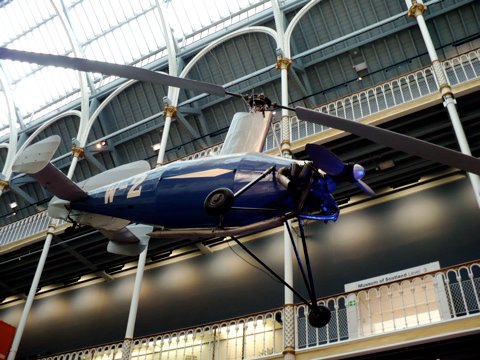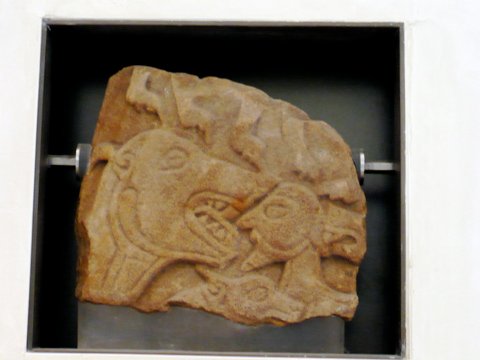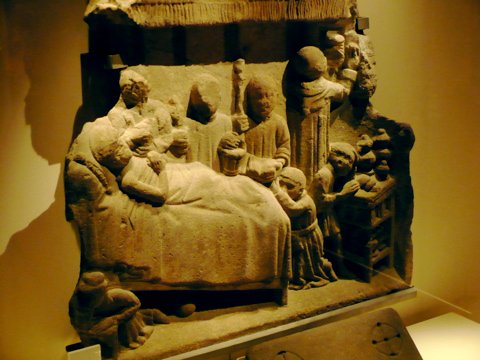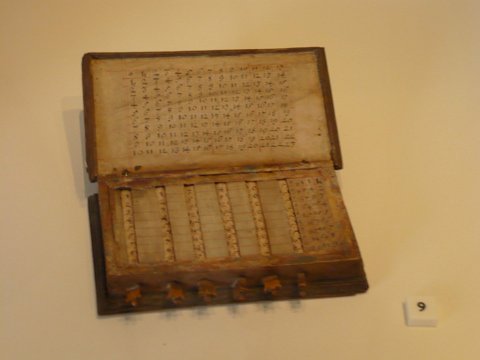
My second (and last) day in Edinburgh was unfortunately pretty much overcast the whole day, so my pictures are a bit dull. But as I spent most of the time indoors, this didn’t matter too much. (Above, Edinburgh Castle from the Princes Street Gardens.)

I first walked to the late-18th century New Town, which has a completely different feel to the Royal Mile: it’s all elegant squares and buildings, rather than closes randomly leading hither and yon. That’s because it was planned from the outset. It’s a stellar example of town planning, beautifully executed. Yay for the Scottish Enlightenment!
The photo is of the Georgian House, Charlotte Square, which at the time belonged to a wealthy merchant. It’s been restored to give visitors an idea of (literally) upstairs-downstairs life.

Not the most exciting photo, I admit! It’s Gladstone’s Land, back on the Royal Mile: another merchant’s house, but built originally in the mid-16th century and extended (upwards!) in the early 17th. And condemned in the early 20th century, but luckily it was bought by the National Trust of Scotland. The restorers uncovered a wonderful painted ceiling in the master bedroom, which I could show you if not for the fact that, as in the Georgian House, no photos are allowed :(

I spent most of the day exploring the Royal Museum and the Museum of Scotland, which are right next to each other — in fact each connected to the other. Together they form the National Museum of Scotland. The Museum of Scotland contains artifacts from Scottish history, whereas the Royal Museum is more about science and technology. But there’s still often a local connection.
This is a Weir W-2 autogyro in the Royal Museum. James Weir was a Scottish industrialist who built and developed Cierva autogyros in the 1920s and 1930s. (His brother, William Weir, was Britain’s second Air Minister, in the closing stages of the First World War.) See also: the Avro-built Cierva at Hendon.

A windtunnel model of the (Scottish) Beardmore W.B. 26 2-seat fighter (first flight 1925). Beardmore were mainly a shipbuilding company, and had mixed success in aviation. They built some very good airships, including R34 (a copy of a Zeppelin) which flew across the Atlantic in 1919, and a huge prototype transport monoplane, the Inflexible, in 1928 (which was underpowered). The RAF never flew the W.B. 26, and apparently even Latvia rejected it. Still, it’s a bit harsh for the placard to say that it was a ‘poorly-streamlined design’. What wasn’t, in 1925? The fact that Beardmore were performing windtunnel tests at all was probably progressive enough.

This one can’t be claimed for Scotland, I’m afraid. It’s a TTV-2 (Towed Test Vehicle), used to test the feasibility of bringing a Gemini spacecraft from orbit onto the ground, slung underneath a parawing, rather than splashing into the ocean as with Mercury. NASA ended up doing it the old-fashioned way. I suspect the 12 little triangle symbols under the hatch represent 12 successful tests.

A few years ago, all the technology pundits could talk about was ‘convergence’ — the idea that one device would sit in your living room and perform all the functions of a TV, computer, DVD player, games console, videophone, pianola, etc. Well, here’s what convergence looked like in 1938 — a combined television and radio. (Clearly, convergence can be followed by deconvergence!) I love the radio tuner. The writing isn’t legible in the small version I’ve got here, but as well as frequencies, it’s marked with the names of cities — presumably the locations of the stations broadcasting on those frequencies: Paris, Warsaw, Moscow, Boston. How evocative would it have been to sweep the dial across the world …
(Oh yes, television, John Logie Baird, Scotsman, inspiration for an annual Australian celebration of mediocrity and all that.)

Another product of Scotland: Dolly, the most famous sheep ever.
The following photos are from the Museum of Scotland.

This is pretty amazing: the Ballachulish figure, which has been dated to between 730 and 520 BC. It was found in a peat bog near where Loch Leven meets the sea, and presumably represents a goddess. It warped and split when it dried after being found, so it wouldn’t have looked quite like this originally. But even so, I think it still would have looked weird.

This fragment of a relief was found on the probable site of an ancient monastery in Ross-shire, ca. 700-900. So it was then Pictland, and not yet Scotland. It is thought to show Daniel in the lion’s den.

A Roman cavalry helmet, found at the fort at Newstead (Roman Trimontium, which was only briefly occupied around 80 and then again during the period of the Antonine Wall, 140-80). It wouldn’t have been used in warfare, but in tournaments or displays.

Another piece of Pictish art, 10th century from Bullion. The caption suggests that it’s a caricature of a drunken lord; the catalogue description just says that he’s drinking. Is the catalogue too conservative or the caption too imaginative?

Hmm, not sure about this one (I forgot to snap the caption). It’s from a gallery about the medieval church, presumably from a tomb. It looks like a deathbed scene, anyway.

Here’s a cast of the graveslab of Donald MacGill’easbuig, a 16th-century mercenary leader from Islay in the Inner Hebrides.

The Maiden, used to execute about a hundred people between 1564 and 1710.

Napier’s Box, a refinement of Napier’s Bones. It’s essentially a simple mechanical calculator which can do multiplication and division, invented by the Scottish mathematician John Napier in the early 17th century.

Despite its superficial resemblance to the Maiden, this is a completely different sort of machine, a Newcomen steam engine. I should point out that while the Scot James Watt made huge improvements to the Newcomen-type engines, and gave the world the steam engines that would power the Industrial Revolution, still, Newcomen was from Devon and his first engines were in Cornwall. The Scottish connection here is that this engine was used at a colliery in Ayrshire until 1901.

A 6-pounder carronade. So cute! I didn’t know that carronades were from Scotland — the name comes from the Carron company which made them for the Royal Navy from 1778. They had a short range and a low muzzle velocity — great for blasting the enemy at short range and shredding them with wooden splinters.

A silk banner for the Mid Lothian Brotherly Society (constituted in the year 1798). I wonder how they’re doing these days.

The Jacquard punchcards from a 19th century handloom from Lanarkshire.

After leaving the museums, I decided to walk up Calton Hill, which has an unusual collection of structures on its top, including the lighthouse-shaped one seen here. (The obelisk on the left is in a cemetery in the foreground; at the bottom of the photo is Waverly Station.)

Nelson’s Monument, built to commemorate Trafalgar. It’s in the shape of a mariner’s spyglass, which is certainly more imaginative than some Nelson monuments I could name. More useful too: the mast on top was used to provide a visual time signal to ships, since the sound from Edinburgh Castle’s one o’clock gun took a couple of seconds to get out there, a potentially serious error when computing longitudes.

I was surprised to find some real telescopes on Calton Hill, or at least the observatory domes which house them. This is the City Observatory, which dates back to 1812 (the dome on the left) and 1896 (the dome on the right). Another building, Observatory House, is the oldest and was built in 1776. I wondered if the observatory had anything to do with the Royal Observatory, Edinburgh, and it turns out that it does, or did — it was the site for ROE between 1822 (when it became royal) and 1896, when it moved to its present location south of Edinburgh. Charles Piazzi Smyth, Astronomer Royal for Scotland and pyramidologist extraordinaire, would have worked here. Slight personal connection: long time ago, I was a summer vacation scholar at the UK Schmidt Telescope Unit (in Australia, despite the name) which was originally operated by ROE. There were still a lot of links with ROE when I was there, with staff coming from and going to there, and the results of observing runs being sent off to their plate library. Today, the City Observatory is run by the Astronomical Society of Edinburgh, which holds observing nights there every month.

Edinburgh’s Disgrace, AKA the National Monument. Monument to what? Well, apparently to the Scotsmen who served in the Napoleonic Wars, though I can’t find it in the UKNIWM (though the Nelson Monument is). It was begun in 1826, intended to be a replica of the Parthenon. But money ran out in 1829, and the 12 columns above are all that were ever completed. Somebody seems to have suggested that it was always intended to be only a partial replica, based on the existence of plans showing exactly what we see today. But an article by Marc Fehlmann in Nineteenth Century Art Worldwide makes it pretty clear that this is not so: there are other drawings showing the full temple, and a quote from one of the architects lamenting the fact that their money has run out and their ‘Parthenon’ will never be finished. Whatever: I think it looks better this way!
On the other hand, my melancholic pleasure at the contemplation of (fake) ancient ruins in the gathering gloom of a northern dusk was not enhanced by some guy belting out arias from all your favourite Italian comic operas. Very strange indeed.

This is from Calton Hill looking back past a memorial to Dugald Stewart, a philosopher who died in 1828, back over the city towards the Castle, which is just visible on the horizon.
Farewell Edinburgh: farewell Scotland: farewell Britain.
![]() This work is licensed under a Creative Commons Attribution-NonCommercial-NoDerivatives 4.0 International License.
Permissions beyond the scope of this license may be available at http://airminded.org/copyright/.
This work is licensed under a Creative Commons Attribution-NonCommercial-NoDerivatives 4.0 International License.
Permissions beyond the scope of this license may be available at http://airminded.org/copyright/.



Pingback: Vidi « Archaeoastronomy
Great stuff. You’re a natural as a tour-guide. Seriously – and I lived there for 10 years!
Btw, I take it you found out that Ballachulish is pronounced ‘Balahoolish’?
No, I didn’t, but nothing surprises me about the Scottish disregard for commonsense pronunciation any longer! I’m sure you do it just to annoy the Sassenachs. (Insert “Dontcha know the Queen’s English?” joke somewhere here.)
So the French pinched the idea of the guillotine, and made it more stylish? Next you’ll be telling us the baguette comes from Glasgow.
It did – the French innovation was to stop frying it in batter.
There was a place near my hotel which sold deep-fried Mars Bars. I’d almost rather haggis.
Pingback: City Observatory ,Calton Hill |